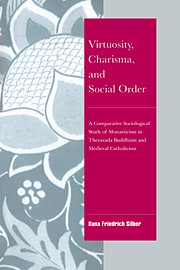 Virtuosity, Charisma and Social Order
Virtuosity, Charisma and Social Order Book contents
- Frontmatter
- Contents
- Preface
- Introduction
- Part I Virtuosi and society: elements of a comparative macrosociological approach
- Part II Virtuosi and society in Theravada Buddhism
- Part III Virtuosi and society in medieval Catholicism
- Part IV Virtuosity, charisma, and social order
- 9 Virtuosity and the virtuoso–society complex
- 10 The virtuoso complex compared
- Conclusion: Religious virtuosity as ideological power: some implications for the comparative study of civilizations
- Bibliography
- Index
9 - Virtuosity and the virtuoso–society complex
Published online by Cambridge University Press: 09 October 2009
- Frontmatter
- Contents
- Preface
- Introduction
- Part I Virtuosi and society: elements of a comparative macrosociological approach
- Part II Virtuosi and society in Theravada Buddhism
- Part III Virtuosi and society in medieval Catholicism
- Part IV Virtuosity, charisma, and social order
- 9 Virtuosity and the virtuoso–society complex
- 10 The virtuoso complex compared
- Conclusion: Religious virtuosity as ideological power: some implications for the comparative study of civilizations
- Bibliography
- Index
Summary
The institutionalization of religious virtuosity in traditional Theravada Buddhism and medieval Catholicism displays some fundamental similarities. Most obviously, virtuosity gave rise, in both settings, to monastic “alternative structures” (in the sense defined in Chapter 2) that shared a number of features and dilemmas. I have tried to show, however, that these inherently precarious structures also relied on different, even contrasting, patterns of institutionalization. A major aim of the comparision was to contradict the frequent assertions of a contrast between other-worldly Buddhist “weakness” and “looseness” vis-à-vis Western Christian “power” and “dynamism” in matters of institutional building and worldly involvement. Buddhism developed in and around the monastic institution a social structure of impressive historical strength and effectiveness that could be properly identified and assessed, it was argued, only by distinguishing between a number of criteria of institutionalization.
In terms of formal organization, autonomy (organizational, economic, and social), and political power, Theravada Buddhist monasticism was shown to be much weaker an institution than its Christian equivalent. In terms of the position of monasticism within the social structure at large, however, Buddhist monasticism appears to have been more solidly institutionalized, retaining, with impressive stability and with only minor variations, a specific social position and pattern of relationship with wider society. In contrast, the position of monasticism in medieval Europe changed with time, was a constant focus of controversy, and was seriously undermined toward the end of the period under study.
- Type
- Chapter
- Information
- Virtuosity, Charisma and Social OrderA Comparative Sociological Study of Monasticism in Theravada Buddhism and Medieval Catholicism, pp. 187 - 198Publisher: Cambridge University PressPrint publication year: 1995
